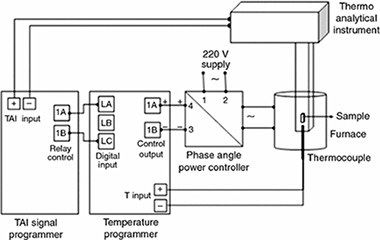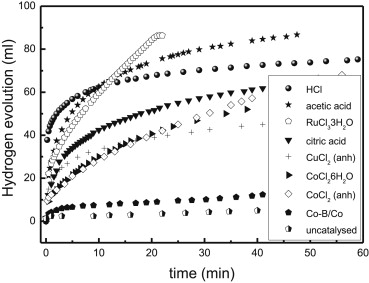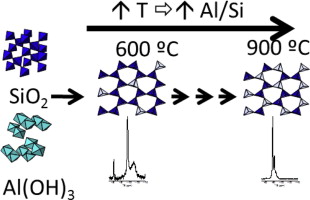Artículos SCI
2015
2015
Reactividad de Sólidos
Applications of sample-controlled thermal analysis (SCTA) to kinetic analysis and synthesis of materials
Perez-Maqueda, L. A.; Criado, J. M.; Sanchez-Jimenez, P. E.; Dianez, M. J.Journal of Thermal Analysis and Calorimetry, 120 (2015) 45-51
Show abstract ▽

The advantages of the sample-controlled thermal analysis (SCTA) for both the kinetic analysis of solid-state reactions and the synthesis of materials are reviewed. This method implies an intelligent control of the temperature by the solid-state reaction under study in such a way that the reaction rate as a function of the time fits a profile previously defined by the user. It has been shown that SCTA has important advantages for discriminating the kinetic model of solid-state reactions as compared with conventional rising temperature methods. Moreover, the advantages of SCTA methods for synthesising materials with controlled texture and structure are analysed.
Abril, 2015 | DOI: 10.1007/s10973-014-4176-6
Materiales de Diseño para la Energía y Medioambiente
Pectin-Lipid Self-Assembly: Influence on the Formation of Polyhydroxy Fatty Acids Nanoparticles
Guzman-Puyol, Susana; Jesus Benitez, Jose; Dominguez, Eva; Bayer, Ilker Sefik; Cingolani, Roberto; Athanassiou, Athanassia; Heredia, Antonio; Heredia-Guerrero, Jose AlejandroPLoS One, 10 (2015) e0124639
Show abstract ▽
Nanoparticles, named cutinsomes, have been prepared from aleuritic (9,10,16-trihidroxipalmitic) acid and tomato fruit cutin monomers (a mixture of mainly 9(10), 16-dihydroxypalmitic acid (85%, w/w) and 16-hydroxyhexadecanoic acid (7.5%, w/w)) with pectin in aqueous solution. The process of formation of the nanoparticles of aleuritic acid plus pectin has been monitored by UV-Vis spectrophotometry, while their chemical and morphological characterization was analyzed by ATR-FTIR, TEM, and non-contact AFM. The structure of these nanoparticles can be described as a lipid core with a pectin shell. Pectin facilitated the formation of nanoparticles, by inducing their aggregation in branched chains and favoring the condensation between lipid monomers. Also, pectin determined the self-assembly of cutinsomes on highly ordered pyrolytic graphite (HOPG) surfaces, causing their opening and forming interconnected structures. In the case of cutin monomers, the nanoparticles are fused, and the condensation of the hydroxy fatty acids is strongly affected by the presence of the polysaccharide. The interaction of pectin with polyhydroxylated fatty acids could be related to an initial step in the formation of the plant biopolyester cutin.
Abril, 2015 | DOI: 10.1371/journal.pone.0124639
Materiales Nanoestructurados y Microestructura
Hydrogen production through sodium borohydride ethanolysis
Arzac, GM; Fernandez, AInternational Journal of Hydrogen Energy, 40 (2015) 5326-5332
Show abstract ▽

In this work, sodium borohydride (SB) ethanolysis was explored for the first time as a method to generate hydrogen for Polymer Exchange Membrane Fuel Cells. Ethanolysis by-product was characterized by Fourier Transform Infrared Spectroscopy, X-Ray Diffraction, and Nuclear Magnetic Resonance. Metal and acid catalysts were tested. RuCl3 center dot 3H(2)O was the best metal catalyst. Acetic acid was selected for the study because of its effectiveness, low cost and relative greenness. The maximum gravimetric hydrogen density obtained was 2.1% wt. The addition of water produces an increase in hydrogen generation rate and a decrease in conversion. The use of ethanol-methanol mixtures produces an increase in reaction rates in absence of catalyst. As a proof of concept the reaction was performed in a small reactor which operates by the addition of ethanolic acetic acid solutions to solid SB (in the form of granules). The reactor produces stable and constant hydrogen generation in the range of 20-80 ml min(-1) during 1 h at constant temperature (around 27-35 degrees.
Abril, 2015 | DOI: 10.1016/j.ijhydene.2015.01.115
Materiales de Diseño para la Energía y Medioambiente
Synthesis temperature effect on Na-Mica-4 crystallinity and heteroatom distribution
Naranjo, M; Castro, MA; Cota, A; Osuna, FJ; Pavon, E; Alba, MDMicroporous and Mesoporous Materials, 204 (2015) 282-288
Show abstract ▽

The discovery of swelling brittle mica, Na-Mica-4, has been one of the most significant advances in the pursuit for a material with high ion-exchange capacity. For technical applications, the control of the phase evolution during the synthesis is crucial. The main aim of this study was to investigate the effect of Na-Mica-4 synthesis temperature on the crystalline phase evolution, Si–Al distribution in the tetrahedral sheet, the Al occupancy between tetrahedral and octahedral sites and their effects on the interlayer space composition. The synthesis temperature range between 600 °C and 900 °C was explored. At low temperature (600 °C), the precursors were transformed in a low-charged swelling 2:1 phyllosilicate, saponite type, which was progressively aluminum enriched with temperature. The high-charged swelling mica was completely formed at 700 °C, although a minor anhydrous contribution remained up to 850 °C. Up to 800 °C, silicates and fluorides secondary phases were detected as a minor contribution.
Marzo, 2015 | DOI: 10.1016/j.micromeso.2014.11.026
Materiales Nanoestructurados y Microestructura
Transmission electron microscopy of thiol-capped Au clusters on C: Structure and electron irradiation effects
Lionel C. Gontard, Rafal E. Dunin-BorkowskiMicron
Show abstract ▽
High-resolution transmission electron microscopy is used to study interactions between thiol-capped Au clusters and amorphous C support films. The morphologies of the clusters are found to depend both on their size and on the local structure of the underlying C. When the C is amorphous, larger Au clusters are crystalline, while smaller clusters are typically disordered. When the C is graphitic, the Au particles adopt either elongated shapes that maximize their contact with the edge of the C film or planar arrays when they contain few Au atoms. We demonstrate the influence of electron beam irradiation on the structure, shape and stability of the Au clusters, as well as on the formation of holes bounded by terraces of graphitic lamellae in the underlying C.
Marzo, 2015 | DOI: 10.1016/j.micron.2014.12.001
- ‹ anterior
- 252 of 420
- siguiente ›














